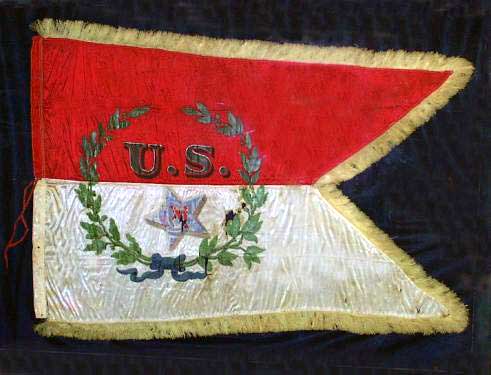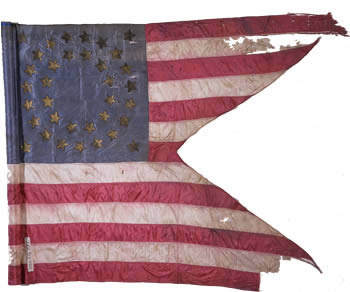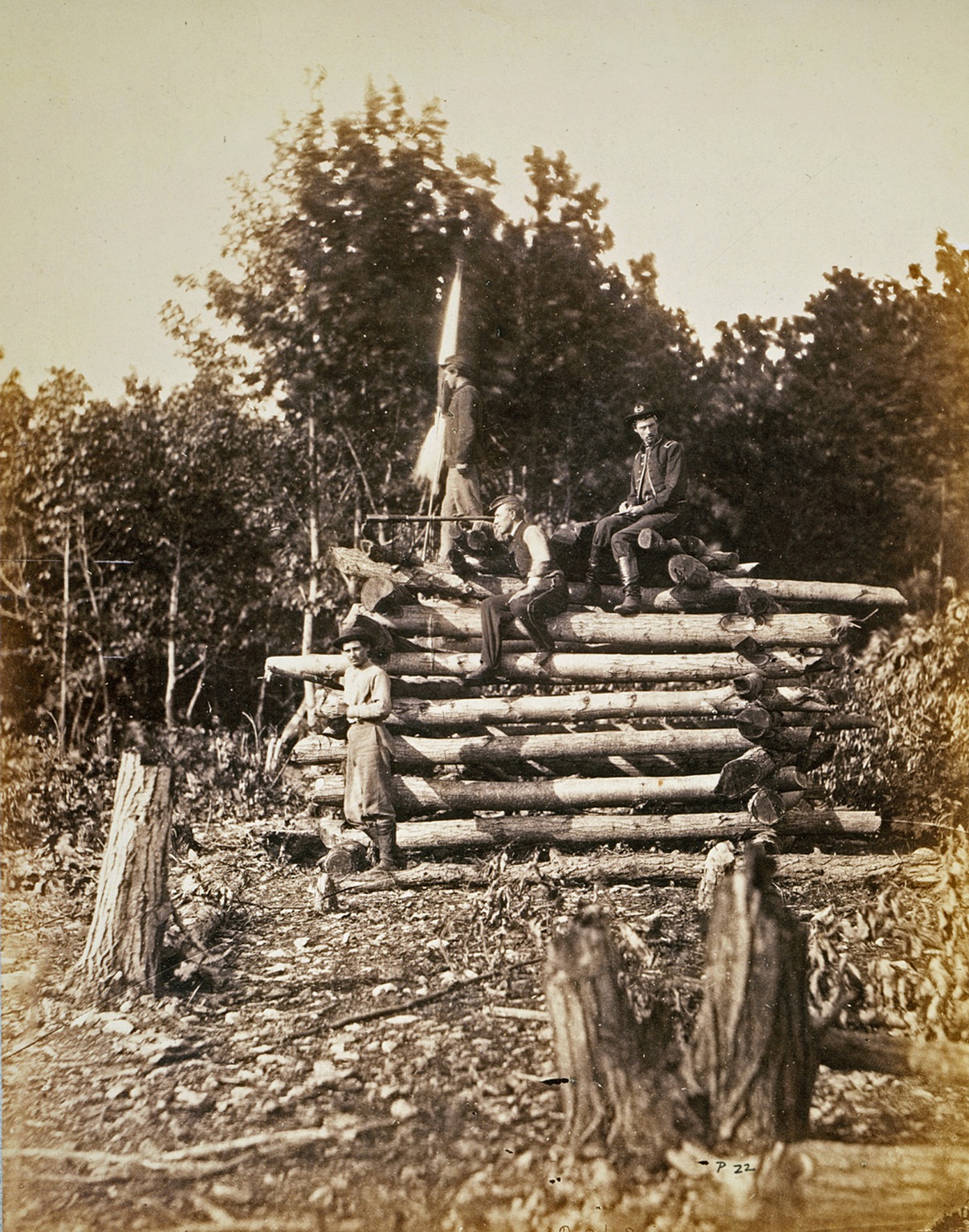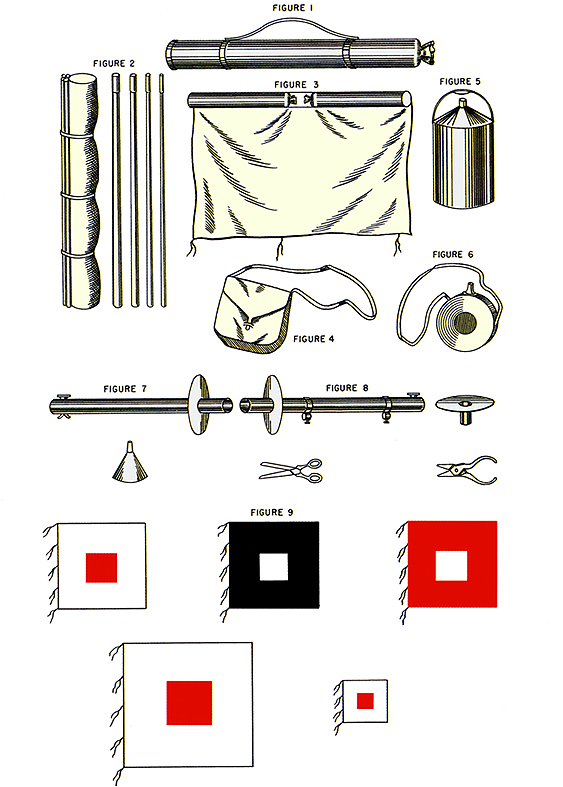
|

|
American Civil War Flags
Union and Confederate Flags
American Civil War Flags
Civil War Colors, Standards, and Guidons
What was the purpose of the Civil War flag?
In military organizations during the Civil War, flags, commonly known as
colors* (colours), standards or guidons, served to specify the rallying point for troops and to identify and locate
the commander.
While many symbols represent the Civil War, few have evoked more emotion
than flags. Units of both North and South carried and fought under four different kinds of flags: (1) state flags; (2)
company flags; (3) national flags; and (4) battle flags. Today, these banners have become artifacts that help tell the story
of the Civil War and those who fought it.
Which units had flags?
The majority of Union and Confederate
units carried unique flags, including headquarters to the lowest unit in
the command.
From headquarters, Army of Northern
Virginia, for example, to corps, divisions, brigades, regiments, to companies carried unique flags. Ships and vessels also
hoisted colors and the U.S. Signal Corps employed flags to signal troop movements and to observe enemy activity behind
the lines. While each modern fort and crude fortification hoisted its flag during the Civil War, indicating allegiance,
it often signaled defiance to an enemy's bombardment. An example in U.S. history of the importance of a single fort and
flag would be Francis Scott Key observing the British bombardment of Fort McHenry during the War of 1812. Key's account
of the event, which later became the national anthem, included the words, "Whose broad stripes and bright stars
through the perilous fight, O'er the ramparts we watched, were so gallantly streaming?
And the rockets' red glare, the bombs bursting in air, Gave proof through the night that our flag was still there; O say does
that star-spangled banner yet wave..."
Most
Union and Confederate soldiers had a lot in common and came from similar backgrounds: from language spoken, identical
education (i.e. West Point produced many generals for both sides), raised in neighboring communities, practiced
the same faith, sang the popular songs of the day, enjoyed familiar food, and during the conflict, their backgrounds
simply carried onto the battlefield with armies employing like tactics and battle formations to using comparable
weapons and flags.
The Flag**
In the early months of Civil War,
both Southern and Northern volunteers joined units organized in their communities. Approximately 100 men made up each
of these units, called companies. Companies frequently took names that identified their homes, such as the Clayton Yellow
Jackets, or the Rutherford Rifles. Ten companies completed a regiment of approximately 1,000 men. During elaborate ceremonies
held before they left for war, companies often were presented with flags made by local women. Sometimes these flags had been
sewn from the silk of women’s dresses, which made them more personal. For the soldiers who marched away to an uncertain
future, company flags represented the love and support of family, friends, and communities.
Colors were often inscribed with the unit's designation, and names of battles
or other symbols representing former achievements. During the Civil War, unique flags were assigned from the highest
level, headquarters, to the basic fighting unit known as the company (ten companies to a regiment), which was generally
raised from the same community. Civil War flags were meticulously designed and often sewn by women in the local
communities where the companies were recruited, so the flag proudly represented their loved ones, their local community,
as well as their nation.
| Genuine Civil War Guidon |

|
| Company M, 2nd Massachusetts Cavalry. Courtesy militarymuseum.org |
The Civil War flag on the battlefield
On Civil War battlefields, regimental colors or flags provided an important
means for soldiers to mark the positions of their regiments and for their officers to convey instructions to the men under
their command.
One can almost hear Leonidas shout, "BATTLE FORMATION!"
Flags employed during war are as old as war itself. An organized and
trained army would employ various formations in combat, so each regiment's ability to maintain its position
during battle was critical to the army's success. A victorious army was a cohesive, coordinated fighting force on
the battlefield, but the unit was subjected to an atmosphere of roaring artillery and discharging weapons,
thus making it difficult to see and hear. As the regiment marched toward its objective, the intolerable
noise and billowing smoke made it impossible to see beyond a few yards or to hear the commander's
orders, so the flag was the rallying point.
Each regiment had a color company
or a color guard, whose assignment was to bear the colors into battle and protect them. Each member of a color guard or company
was selected for this position based on his courage and steadiness under fire, by the regimental commanders. The flags were
carried by unarmed color sergeants, and accompanied by armed color corporals, who were instructed not to engage in
combat unless the flags were in immediate danger of capture, The flags became the physical symbol of a units pride and courage,
a rallying point in combat and the source of many heroic deeds in their defense.
What is the difference between a Civil War flag and guidon?
Guidon is the name given to a small flag or pennant carried as a standard
by a military unit. The Civil War guidon, usually made of silk, was the military standard carried by cavalry, known as
troops, artillery batteries, and by some infantry units. The guidon signified unit designation and corps affiliation.
A basic guidon was usually rectangular, but sometimes had a triangular portion removed from the fly (known as "swallow-tailed").
Cavalry troops carried the "swallow-tailed" flags on horseback with the "V" of fabric cut away, making the flag lighter and
less resistant to wind. The Civil War flag, known as colors or standard, was generally made of wool and carried into
battle by units which did not carry guidons. Although infantry regiments primarily used flags, some infantry companies
and regiments carried silk guidons. While each infantry company (ten companies formed a regiment) carried its flag
into battle, the regimental flag was the rallying point.
(Right) This is the original cavalry guidon
flown by Company M of the 2nd Massachusetts Cavalry. The oil painted laurel wreath surrounds block U.S. with a star device
and C circumscribing a block M in center. The guidon's overall dimensions are 30" X 40". It is surrounded by gold fringe.
The guidon was one of four California Battalion company flags presented in March of 1863 when they departed San Francisco.
The presenter was Daniel Norcross, a local regalia supplier. When the four companies arrived in Boston, they were re-designated
E, F, L, and M with C Co., receiving the "M" designation, thus clarifying the presence of both the C and M devices on the
guidon. (Mike Sorenson Collection)
|

|

|

|

|
| New York State Military Museum |

|
| 111th New York Infantry Regimental Guidon |
What was the primary purpose of the Civil War flag during battle?
The purpose of the Civil War flag was the same for both Union and Confederate
armies. The regimental flag was an integral part of the unit by serving as the focal point for soldiers during
battle. Commands were often conveyed to the soldiers by musicians, but the
colors, carried by the guide, signaled each movement to every soldier in the unit. The flag was vital to the army's
coordinated movements, so the enemy intentionally aimed at the guide or color bearer making it common for 3
or 4 standard bearers to fall in a single battle. (A similar tactic was applied to enemy cavalry and artillery, because soldiers
shot the horses to immobilize the units.)
(Right) 111th New York Infantry Regimental Guidon. This silk swallowtail
guidon, used as a marker to assist in battlefield maneuvers, conforms to the “stars and stripes” pattern described
in General Order No. 4, Headquarters of the U.S. Army, dated January 18, 1862. Deposited into the collection in July 1865,
this fragile flag’s blue canton has faded significantly. Note the cloth identification label, possibly added in July
1865, at the bottom hoist. The 111th fought in numerous major battles, including the Wilderness and Spotsylvania Court
House, and it suffered 249 casualties at Gettysburg in July 1863.
During a Civil War battle, troops fought in a line, or what is known as linear formation.
The regimental colonel stood behind the center of the line, with the color guard and color bearer placed directly in front
of him. Due to the terrific battlefield noise caused by the firing of rifles and cannons, exploding shells, and screams of
wounded and dying men, soldiers often heard few commands. So the colonel passed his orders on to the color bearer with his
battle flag. All of the troops in the battle line watched the color bearer and followed his movements. If the colonel ordered
the regiment forward, for example, the color bearer raised his flag and moved forward.
Because of this role in leading the regiment, the color bearer became one of the most important
men on the battlefield—and a constant target for enemy soldiers. Men who carried the battle flag were chosen for their
steadfastness and bravery. Eight men composed the color guard, which meant another soldier could quickly retrieve the flag
if the man holding it went down. Carrying the flag into battle was a dangerous job, with tremendous casualty rates. But there
was never a shortage of volunteers. As the men went into combat, their battle flag became a visible symbol for all of the
reasons they were willing to fight and die.
There were more medals of honor bestowed
on soldiers for capturing the enemy's colors than for any other action during the Civil War. Many historians and authors often graphically
describe how a single soldier heroically captured the enemy's flag, while describing the pinnacle event as more
than humiliating and embarrassing for the flagless unit. But colors were not merely blissful tokens
and trophies of war nor were they symbolic colorful clothes wavering across smoke filled battlefields. Yes, men
and boys from the same community proudly gripped the standard made by local women, and yes while each flag bearer fell
casualty to enemy shot and shell, another soldier eagerly snatched the blood stained standard from the fallen while
continuing to advance into grape and canister shot, but regimental colors was vital to each unit's movements during battle,
but the primary purpose of the regimental colors was to communicate movements to every soldier in the regiment. When
the color bearer, also known as guide, obeyed a command, i.e. left oblique, the soldiers in the regiment would view and then
march in the direction of the flag. Often times soldiers to the rear were unable to see the colors, so they merely
followed the movement of the soldier directly to his front.
Modern warfare tactics do not call for rallying points in the open, with
large numbers of men performing intricate maneuvers. Therefore, today's armies use colors in ceremonies but do not carry them
into battle.
| Civil War Flags and U.S. Signal Corps |

|
| U.S. Signal Corps at Battle of Antietam |
(About) U.S. Army Signal Corps station on Elk Mountain, Maryland, overlooking
the Antietam battlefield.
| Civil War Flags |

|
| US Signal Corps Kit and Civil War Flag History |
The U.S. Signal Corps was officially established by Major Albert J. Myer, U.S.
Army, on June 21, 1860, and less than one year prior to Civil War. Armies through the ages used drums, trumpets, and banners to communicate on the battlefield.
Although these methods were used in the Civil War, both armies introduced a new signal technology that permitted
rapid communication across the battlefield. The new system employed flags during the day and torches at night to communicate
movements and commands. With signal stations on the field and surrounding ridges, the U.S. Signal Corps operated effectively
during major battles such as Antietam and Gettysburg, not only sending messages, but also observing behind the Confederate
lines. The Confederate Signal Corps performed duties and utilized equipment very similar to their Northern counterparts, with
some exceptions. Electric telegraphy was not used in tactical battlefield communications due to shortages of telegraph wire
and trained operators, but "wig-wag" signaling was performed by both armies with similar flags, but with slightly
modified codes and movements. Both services provided valuable battlefield intelligence, and sometimes artillery fire
direction, from their elevated observation points, but the Confederate corpsmen performed undercover missions behind enemy
lines as well.
(Right) Signal Kit. Figure 1: complete signal kit when packed; figure
2: contents of signal kit, ready to be placed in the canvas case (the four joints of the staff are bound to the rolled flags);
figure 3: torch case(made of rubber cloth about three feet long by two and one-half feet wide; the torches were inserted into
pouches inside the case); figure 4: haversack; figure 5: service can (capable of carrying five gallons of fuel); figure 6:
canteen; figure 7: flying torch with flame shade attached; figure 8: foot torch with flame shade attached; figure 9: signal
flags, showing their relative sizes.
The oldest
flag system associated with the U.S. Army Signal Corps is called Wig-wag. The name reflects the concept of back and forth
movement as a means of signaling through motion. Wig-wag is the signaling system developed for military field operations by
Army surgeon Albert J. Myer prior to the Civil War. He developed this system based on a two element “tap-code”
he created for the deaf. Myers’ Wig-wag system uses one flag for signaling. The position of the flags, left, right,
front, represent the numerals 1, 2, 3 respectively and combinations of these numerals are used to convey the message.
The one-flag
Wig-wag system used a cotton flag of two, four, or six feet square. The larger the flag, the greater distance it could be
seen. The flag pole could be extended to a length of 16 feet using 4-foot segments joined with brass fittings. It took a strong
soldier to wave a 16 foot pole with a 6-foot square flag on it for an hour or more, especially in wind, heat and probably
under enemy fire. During night operations, the flag was replaced with a specially designed kerosene fueled torch, but employed
exactly as the flag would be during daytime. During daytime operations, different sizes and colors of flags were employed
based upon atmospheric conditions, such as clouds, haze, blue sky, etc. The signal soldier had these varieties of flags as
part of their kit, but at any one time, only one flag or torch was used for signaling.
The Myer
Wig-wag system and associated codes were used by both Union and Confederate armies during the Civil War. The Union Navy also
employed this system and it served as the first Joint Signal Code between the Army and Navy until the end of the nineteenth
century.
Loss of Colors
There is no official definition of the term "loss of colors." However, the
term, in common usage, refers to the capture of a unit's colors (flags) by the enemy in battle, or the taking away of a unit's
colors as a punishment or disciplinary measure.
"Colors" or unit standards have historically served as a means of identifying
units of the battlefield. During the Civil War, men were trained to follow their colors in battle, to "rally" around them,
and generally to use them to maintain unit cohesiveness. Unit colors were a great source of pride, and victories or defeats
were often expressed in terms of colors being captured from or lost to the enemy. During the Civil War, many awards of the
Medal of Honor were made for the capture or defense of colors. Even then, however units which lost their colors remained intact
and continued to fight.
Use of military flags today
Due to the advent of modern weapons, and subsequent changes in tactics,
colors are no longer carried into battle, but continue to be used during formal events and ceremonies.
*The word colours is of British origin, and over the centuries the word colors
has been adopted by the armed forces of the United States. In the U.S., American English
has gradually shortened most words inherited from Great Britain. Other examples include most words ending in an
unstressed -our in British English (e.g. colour, flavour, harbour, honour, humour, labour, neighbour, rumour) end in -or in
American English (color, flavor, harbor, honor, humor, labor, neighbor, rumor).
See also
**Union and Confederate Flags Data Base
Please note these are searchable PDF documents, which contain Civil War flags with descriptions. Courtesy
The Museum of the Confederacy.
Sources: Library of Congress, army.mil, North Carolina Museum of History,
militarymuseum.org, National Park Service; Texas Civil War Museum; North Carolina Archives; The Museum of the Confederacy
online moc.org.
Return to American Civil War Homepage

|

|

|

